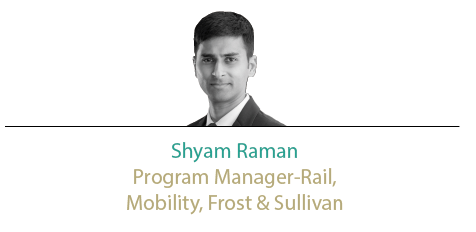
The integration of mobility is driving growth in all rail segments globally. Demand for improved efficiency in the rail industry will drive the market for advanced asset and fleet management tools, including remote diagnostics (or prognostics), passenger information and asset planning. Recent research has shown that intelligent solutions (such as rail automation) that help increase efficiency without compromising on safety are receiving dramatically high interest levels. The radio-based Communication-Based Train Control (CBTC, which allows metro and subway systems to operate driverless trains) network in western Europe is expected to grow at a CAGR of 22.8% over the next ten years, according to a recent Frost & Sullivan study.
Every transport mode is important and integral for providing seamless connectivity. Subways and heavy metro rail systems are available in city centres in urban areas.
Operating capacities of 70,000 to 120,000 passengers per hour per direction (p/h/d) are possible, with advances in signalling technologies eliminating the requirement for a driver. Light rail and guideway systems enable urban areas to have highly efficient mobility until the need for heavy metro solutions is warranted. PRT/ GRT/BRT systems have an ideal capacity of 10,000-15,000 p/h/d and can operate feeder routes to urban rail nodes for bridging the gap. Conventional buses can handle capacities in the range of 3,000-5,000 p/h/d. Car sharing, bike sharing, and other non-motorised transportation options emerge as being critical in delivering last-mile connectivity.
The Hyperloop is not the only radical transport solution currently in development. The Canadian firm Magnovate aims to commercialise a new Maglev system - ‘Magline’. Magline’s design speed will be 300 miles per hour on inter-city routes and up to 90mph in the urban setting. Magline vehicles are smaller, and similar to pod-type personal rapid transit vehicles. Magline further improves on system economics by utilising a ‘packet switching’ model that enables offline stops without slowing traffic on the main line. This allows more vehicles that are not connected to one another to run more often on the network.
A project is being developed to connect the cities of Edmonton and Calgary with a Magline track. The planned length will be just over 180 miles, and it is expected to cost $3.6 billion (£2.8bn). The current travel time of three hours by road and 1½ hours by air will be reduced to less than 45 minutes by Magline - a small vehicle on a small guideway with high-speed magnetic levitation achieved by using a revolutionary technology called stabilised permanent magnate suspension.
The rail research group at Frost & Sullivan finds that global high speed rail has enormous interest levels, with total expected investment funding in high speed rail infrastructure of more than $770.23bn (£601.3bn) by 2022, and more than $60bn (£46.8bn) expected in North America through California high speed rail.
There is a gradual transition in the way that information technology is being integrated in transportation systems. It is not only being implemented and enabling new technologies and applications in transportation, it is also becoming inherent and an integral element. It is expected that transit systems of the future will be a network that is sentient, self-sustaining and cognitive in nature. And rail systems will play the role of the central nervous systems in those networks.











